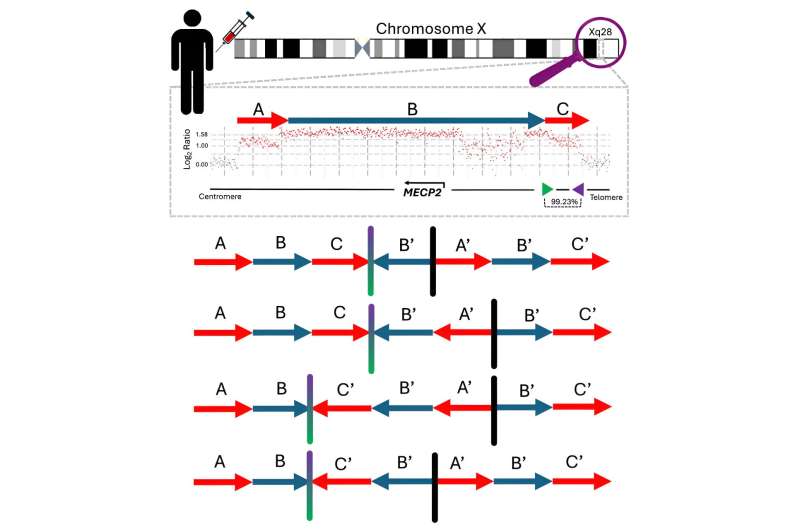
Image summary. Balance: Cellular genomics (2024). DOI: 10.1016/j.xgen.2024.100590
Researchers at the Pacific Northwest Research Institute (PNRI) and partner institutions have made a discovery that could significantly advance our understanding of genetic disorders. Their latest research, published in the journal Cellular genomicsshows how specific DNA rearrangements called inverted triplications contribute to the development of various genetic diseases.
Genomic disorders occur when there are mutations or changes in DNA that disrupt normal biological functions. These can cause a variety of health issues, including developmental delays and neurological problems. One type of complex DNA mutation involves a structure known as double-duplication/inversion-duplication (DUP-TRP/INV-DUP). This research focuses on how this complex rearrangement is created and its impact on human health.
The research team, led by PNRI Assistant Investigator Cláudia Carvalho, Ph.D., collaborated with lab colleagues, lead study author Christopher Grochowski, Ph.D., from the James R. Lupski Lab at Baylor College of Medicine , and other scientists. analyzed the DNA of 24 individuals with inverted triage.
They found that this rearrangement is caused by parts of the DNA switching templates during the repair process. Typically, DNA repair methods use the undamaged complementary strand as a template to correctly repair the damaged DNA. However, sometimes during repair, the repair machinery can inadvertently switch to a different but identical sequence elsewhere in the genome.
These switches occur within pairs of inverted repeats—segments of DNA that are mirror images of each other. Inverted replication can confuse the repair machinery, leading to the use of an incorrect template, which can disrupt normal gene function and contribute to genetic disorders.
- Structural Diversity: The study found that this altered splicing produces a surprising variety of structures in the genome, which can lead to different health outcomes.
- Gene dosage effects: These rearrangements can change the number of copies of a particular gene, known as gene dosage. The correct number of gene copies is essential for normal human development and function. Changes in gene dosage can cause diseases such as MECP2 duplication syndrome, a rare neurodevelopmental disorder.
- Mapping sites: Using advanced DNA sequencing techniques, the researchers identified the precise locations where these stretches of DNA change templates leading to an altered number of genes including MECP2.
Scientists of Dr. Carvalho and Baylor first observed this pathogenic genomic pattern in 2011 while studying MECP2duplication syndrome. Only recently, with the advent of long-read sequencing technology, has it been possible to study in detail how it forms in the genome.
“This study sheds light on the complex mechanisms that drive gene rearrangements and their profound implications for rare diseases,” said Dr. Carvalho, PNRI’s principal scientist on the study. “By visualizing these complex DNA structures, we are opening new ways to understand the genetic causes of rare diseases and develop targeted therapies to improve patient outcomes.”
These findings are being used in a follow-up study led by Davut Pehlivan, MD of Baylor, MD, to examine how complex genetic structures influence the clinical features of MECP2 duplication disease and their implications for targeted therapeutic approaches.
More information:
Christopher M. Grochowski et al, Altered resolution formed by frequent template switches generates structural variation in a genomic disease region, Cellular genomics (2024). DOI: 10.1016/j.xgen.2024.100590
Presented by the Pacific Northwest Research Institute
Quote: Study uncovers hidden DNA mechanisms of rare genetic diseases (2024, June 21) retrieved on June 24, 2024 from https://medicalxpress.com/news/2024-06-uncovers-hidden-dna-mechanisms-rare.html
This document is subject to copyright. Except for any fair use for personal research or research purposes, no part may be reproduced without written permission. The content is provided for informational purposes only.
#Research #reveals #hidden #DNA #mechanisms #rare #genetic #diseases